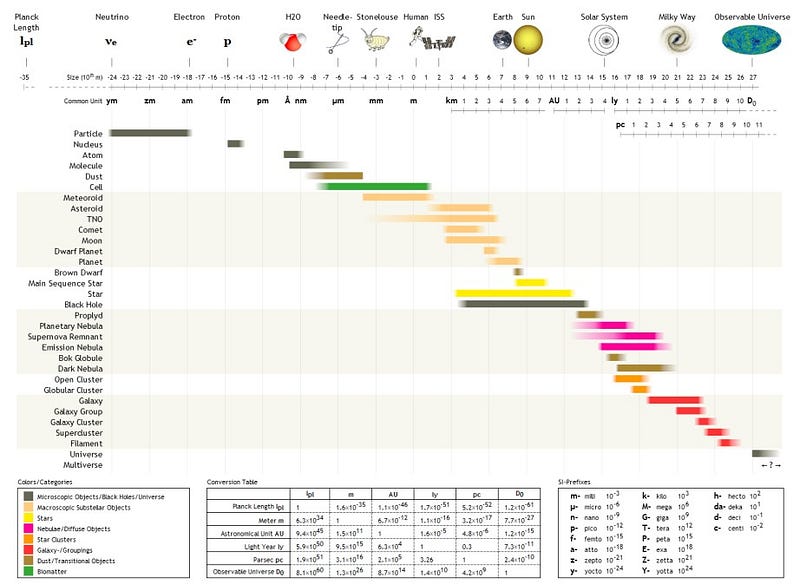Understanding the Cosmic Scales: A Journey Through the Universe
Written on
Chapter 1: The Marvels of Cosmic Scales
The Universe, with its incredible size and complexity, often leaves us in a state of wonder. To truly appreciate its vastness, one must investigate the various astronomical scales that help us understand its dimensions.
Non-members can view a shortened version of this article here.
From the tiniest particles to the grandest galaxies, these scales serve as a framework for us to comprehend the immense distances and sizes that exist within our Universe. In this article, we will examine several of these scales and relate them to familiar examples to enhance our understanding.

Length Scales
Astronomical Unit (AU)
The average distance from Earth to the Sun.
Approximate Value: 1 AU = 1.496 × 10^8 km
Light-year
The distance light travels in one year.
Approximate Value: 1 light-year = 9.461 × 10^12 km
Example: Proxima Centauri, our closest stellar neighbor, is about 4.24 light-years distant.
Parsec
Definition: Parallax of one arcsecond.
Approximate Value: 1 parsec ~ 3.086 × 10^13 km
Example: Alpha Centauri, another nearby star system, is roughly 1.3 parsecs away.
Megaparsec
Definition: One million parsecs.
Approximate Value: 1 Mpc = 3.086 × 10^19 km
Example: The Virgo Supercluster is located approximately 16 Mpc away.
Observable Universe
Definition: The segment of the Universe visible from Earth.
Estimated Radius: ~ 46.5 billion light-years
Example: The observable Universe acts as a cosmic horizon, beyond which events have yet to impact us due to the finite speed of light.
Schwarzschild Radius
Definition: The radius that defines the event horizon of a black hole.
Approximate Value: Rs = 2GM/c², where G is the gravitational constant, M is the mass of the black hole, and c is the speed of light.
Example: For a black hole with the mass of the Sun, the Schwarzschild radius is about 3 km, meaning if the Sun were to collapse into a black hole, it would fit within a sphere of this radius.
Cosmological Scale
- Age of the Universe: Approximately 13.8 billion years
- Hubble Constant H0: Represents the Universe's expansion rate. Current estimates suggest H0 ~ 70 km/s/Mpc.
Mass Scales
Solar Mass
Definition: The mass of the Sun, used as a standard unit in astronomy.
Approximate Value: 1 Solar Mass ~ 1.989 × 10^30 kg
Example: Stellar masses are frequently expressed in multiples of solar masses; for instance, our Sun is about 1 Solar Mass.
There are numerous additional scales worth exploring, such as temperature, density, and magnetic field scales, which may be essential as our understanding deepens. While it’s challenging to predict the complete range of necessary scales, we will continue updating this list and linking to related articles.
If this article has sparked your curiosity and you wish to learn more, feel free to express your thoughts in the comments or through social media. Your engagement is invaluable as we explore the mysteries of the Universe together. For those looking to support our work further, consider joining our Patreon or Ko-fi community. Thank you, and we look forward to our next adventure!
Chapter 2: Practical Applications of Scales
The first video demonstrates how to effectively set up and use the Escali Health Monitor Bath Scale. It provides a comprehensive guide to ensure accurate measurements, essential for anyone interested in monitoring their health metrics.
The second video focuses on calibrating digital scales, explaining the importance of proper calibration for achieving precise readings in various applications.